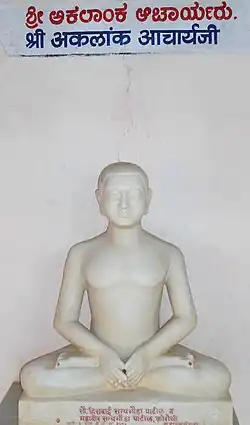Akalanka
Acharya Shri 108 Akalanka Ji Maharaj | |
|---|---|
 Image of Acharya Akalanka | |
| Personal life | |
| Born | 720 CE |
| Died | 780CE |
| Religious life | |
| Religion | Jainism |
| Sect | Digambara |
| Part of a series on |
| Jainism |
|---|
 |
Akalanka [IAST: Akalaṅka] (also known as Akalaṅkadeva and Bhatta Akalaṅka) was a Jain logician whose Sanskrit-language works are seen as landmarks in Indian logic.[1][2] He lived from 720 to 780 C. E. and belonged to the Digambara sect of Jainism.[1][3] His work Aṣṭaśatī, a commentary on Āptamīmaṃsa of Acharya Samantabhadra deals mainly with Jaina logic. He was a contemporary of Rashtrakuta king Krishna I. He is the author of Tattvārtharājavārtika, a commentary on major Jain text Tattvartha Sutra. He greatly contributed to the development of the philosophy of Anekantavada and is therefore called the "Master of Jain logic".[4][5]
Life
Akalanka flourished in 750 C. E.[6] He was aware of the contents of the Angas, although it cannot be said whether they represent an idea rather than a reality for him, and he also seems to have been the first Digambara to have introduced as a valid form of scriptural classification the division into kalika and utkalika texts which was also employed by the Śvetāmbaras.[7] He is mentioned as a logician and a contemporary of Subhatunga and Rashtrakuta king Krishna I.[6]
The samadhi of Acharya Akalanka is located between Thurupammor and Karanthai villages, at a distance of 19 km from Kanchipuram, Tamil Nadu.
Works
The following Sanskrit-language works are attributed to Akalanka. Some of these are:[8][9]
- Laghīyastraya: A compendium of three small treatises - Pramāṇapraveśa, Nayapraveśa, and Pravacanapraveśa.[10]
- Pramānasaṅgraha: A work on epistemology or pramāṇa.
- Nyāyaviniścaya: A work dealing with perception, inference and pravacana.[10]
- Siddhiviniscaya-vivarana
- Aṣṭaśatī: A short but important commentary on Samantabhadra's Aptamimamsa.[10]
- Tattvārtharājavārtika: A commentary on Tattvartha Sutra resembling to Nyāyavārtika of Udyotakara[10]
See also
- Acharya Shri Akalanka Educational Trust
- Karanthai Samadhi of Acharya Akalanka at Thurupammor-Karanthai, Tamil Nadu [11]
- Devardhigani Kshamashraman
- Hemachandra
- Hiravijaya
Notes
- ^ a b Akalaṅka; Goyal, Devendra Kumar (1 January 2005). The Enlightened Vision of the Self. Radiant Publishers. p. 1,2. ISBN 9788170272441.
- ^ Ganga Ram Garg (1992). Encyclopaedia of the Hindu World. Concept. p. 288. ISBN 978-81-7022-375-7.
- ^ Singh & Baruah 2003, p. 9.
- ^ Singh & Baruah 2003, p. 110.
- ^ Singh & Mishra 2007, pp. 9–13.
- ^ a b Vidyabhusana 2006, p. 186.
- ^ Dundas 2002, p. 80.
- ^ Singh & Baruah 2003, p. 32.
- ^ Sures Chandra Banerji (1989). A Companion to Sanskrit Literature. Motilal Banarsidass. p. 10. ISBN 978-81-208-0063-2.
- ^ a b c d Maya Dhawan. Siddhi Vinischaya Of Anant Viracharya And Its Vritti Of Bhatt Akalanka Deva Mahendra Kumar Jain.
- ^ Pushpathanathar Jain Temple, Thurupammor-Karanthai
References
- Dundas, Paul (2002) [1992], The Jains (Second ed.), Routledge, ISBN 0-415-26605-X
- Singh, N.K.; Mishra, A.P. (2007), Encyclopaedia of Oriental Philosophy, vol. 7, Global Vision Publishing House, ISBN 978-81-8220-113-2
- Singh, Nagendra Kr; Baruah, Bibhuti (2003), Encyclopaedic Dictionary of Pali Literature, Global Vision Publishing House, ISBN 978-81-87746-67-6
- Vidyabhusana, Satis Chandra (2006) [1920], A History of Indian Logic: Ancient, Mediaeval and Modern Schools, Motilal Banarsidass, ISBN 81-208-0565-8
Further reading
- Akalaṅka. Tattvārthavārttikā (Rājavārttikam), ed. Mahendrakumar, 2 vols, Kashi, 1953 and 1957.